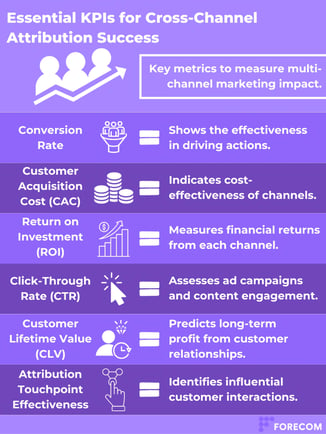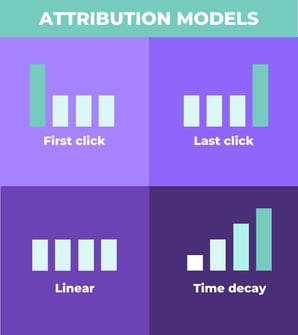Our aim in this article is to simplify the process of measuring cross-channel marketing. We’ll explore how to implement cross-channel attribution effectively, and how to analyze and interpret the data you collect.
Content
Techniques in Measuring Marketing Channel Performance
Implementing Cross-Channel Attribution
Analyzing and Interpreting Attribution Data
Introduction
This cross-channel marketing approach offers immense potential to engage audiences, but it also poses a significant question: How do you measure the success of your marketing efforts across different channels?
This is where the concept of cross-channel attribution comes into play. It’s a strategy that helps marketers understand which channels are truly driving results, enabling them to allocate their resources more effectively. However, for many, navigating through the data and analytics can be daunting.
But don’t worry, by the end of this article, you’ll have a clearer understanding of how to measure and maximize the success of your marketing campaigns across various channels.
Techniques in Measuring Marketing Channel Performance
Cross channel marketing is not just about using multiple channels, but knowing how well each one works. Let’s break down some effective techniques to measure this performance in a clear and straightforward manner.
Key Metrics for Each Channel
Different channels offer different kinds of data. For instance, you might look at likes and shares for social media, but focus on open rates for email campaigns. The trick is to pick the right metrics that align with your goals for each channel.

Related: Read more about Measuring and improving customer lifetime value
Comparing Channels Effectively
Instead of trying to find the 'best' channel, compare how each contributes to your overall goals. For example, social media might be great for getting people talking, while emails could be your star player for actual sales conversions.
A/B Testing: The Experiment Game
Think of A/B testing like a science experiment. You change one thing across different channels to see what works best. Maybe it’s a different call-to-action or a new image. It’s all about testing and learning.
Mapping the Customer Journey
It's crucial to track where and how customers interact with your campaign. Tools that map the customer journey show you the full path from the first click to the final purchase, giving you insights into how well each channel works together.
Powering Up with Analytics Tools
To tie it all together, use analytics tools. They're your command center for tracking, analyzing, and making sense of data from all your channels. This way, you can make smarter decisions based on up-to-date information.
Implementing Cross-Channel Attribution
After exploring various ways to measure marketing channel performance, let's dive into how you can effectively put cross-channel attribution into action.
Choosing the Right Attribution Model
The first step in implementing cross-channel attribution is selecting a model that fits your campaign goals. Whether it's the first-click, last-click, linear, or time-decay model, each one offers a unique perspective on how your marketing channels contribute to conversions.

First-Click Attribution Model
- Usage: Ideal for businesses focused on raising awareness or expanding their market reach.
- Purpose: Helps in identifying which channels are most effective at generating initial interest or drawing new potential customers into the sales funnel.
- Best for: Marketing strategies that are aimed at the top of the funnel activities, like brand campaigns or introductory offers.
Last-Click Attribution Model
- Usage: Best suited for evaluating the efficiency of channels in closing sales or driving final decision-making.
- Purpose: Useful in assessing the effectiveness of direct response campaigns or bottom-of-the-funnel activities.
- Best for: Businesses that prioritize conversions and sales over other stages of the customer journey, such as e-commerce platforms.
Linear Attribution Model
- Usage: Ideal for a holistic view of the marketing strategy, recognizing the role of each touchpoint equally.
- Purpose: Helps in understanding the overall customer journey and the importance of maintaining consistent messaging and brand presence across all channels.
- Best for: Companies with multi-channel strategies seeking a balanced approach to attribution, ensuring all efforts are recognized.
Time-Decay Attribution Model
- Usage: Most effective for campaigns with a short sales cycle or when there's an emphasis on recent marketing efforts.
- Purpose: Highlights the influence of marketing tactics that occur closer to the time of conversion, acknowledging that recent interactions might have a greater impact on the decision-making process.
- Best for: Businesses with rapid conversion paths, like time-sensitive promotions or flash sales, where recent engagements are more likely to lead directly to conversions.
Unifying Data from Different Channels
To get a clear picture of how your marketing is doing, it's important to put together all the information from your different marketing channels. This means taking data from places like your social media accounts, email campaigns, online ads (PPC), and how well your website is doing in search results (SEO).
Setting Up Tracking
Good tracking is crucial. It involves:
- Using specific codes (like UTM parameters) for website traffic.
- Implementing pixels for tracking online ads.
- Creating unique URLs for email campaigns.
Using Analytics Tools
For deeper insights, use tools like Google Analytics or Adobe Marketing Cloud. These can automate a lot of the data collection and analysis, making your job easier.
Analyzing and Interpreting Attribution Data
Once you've implemented cross-channel attribution in your marketing strategy, the next crucial step is to analyze and interpret the data you've collected. This process transforms raw numbers into meaningful insights, guiding strategic decisions for your campaigns.
Decoding the Data: Understanding What It Tells You
- Breaking Down Channel Performance: Look at each channel’s data to understand its role in your marketing strategy. How does each channel contribute to conversions? Are some channels better at starting customer journeys, while others excel at closing the deal?
- Identifying Patterns and Trends: Search for patterns in the data. Do certain channels perform better at specific times or with particular demographics? Understanding these patterns can help you optimize your strategy.
Comparing Attribution Models
- Cross-Model Analysis: If you've used multiple attribution models, compare the insights from each. This comparison can reveal different aspects of how each channel performs, offering a more rounded view of your strategy's effectiveness.
- Model Effectiveness: Assess which attribution model provides the most useful insights for your objectives. Sometimes, the model you start with might not be the most effective, so be open to changing your approach.
Making Data-Driven Decisions
- Strategic Adjustments: Use your data analysis to inform decisions about budget allocation, channel focus, and campaign adjustments. If one channel is outperforming others, consider reallocating resources to capitalize on its success.
- Experimentation Based on Insights: Don’t hesitate to experiment with new approaches based on your data insights. For example, if the data suggests a particular type of content works well on a certain platform, try creating more of that content.
Conclusion
Cross-channel attribution shows how different marketing channels contribute to your overall campaign success, allowing for precise measurement and informed strategy adjustments. As you apply these insights, your marketing efforts can become more targeted and effective.
If you need deeper insights or personalized guidance on implementing cross-channel attribution or analyzing its outcomes, we're here to assist. Don’t hesitate to contact us and book a free consultation.
FAQ
1. What is cross-channel attribution?
It's a method to identify which marketing channels contribute to sales or other customer actions, highlighting the impact of each channel.
2. Why is cross-channel attribution important?
Cross-channel attribution is crucial as it helps marketers understand the synergistic effect of different channels and guides effective budget allocation for maximum impact.
3. What challenges does cross-channel attribution involve?
The main challenges in cross-channel attribution include managing data from multiple sources and selecting the most effective method to measure the impact of each channel.
4. What tools are used for cross-channel attribution?
Tools like Google Analytics are widely used for tracking and analyzing data across various marketing channels in cross-channel attribution.